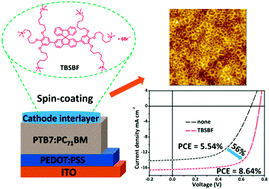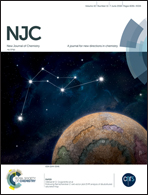Constructing efficient organic photovoltaic devices with a spirobifluorene based water/alcohol-soluble cathode interlayer
Abstract
A water/alcohol soluble small molecular cathode interlayer (CIL) with the quaternary ammonium ions terminated by trihydroxybenzene as the pendant polar functionalities and a commercially available spirobifluorene (SBF) as a 3D-structural conjugated backbone, namely, TBSBF, was synthesized and applied in conventional single-junction polymer solar cells (PSCs). TBSBF was found to effectively enhance the performance of the PSCs by simultaneously increasing the open-circuit voltage (Voc), short-circuit current (Jsc) and fill factor (FF). Combined measurements of the current density–voltage characteristics, ultraviolet photoemission spectroscopy (UPS) and the electron mobility demonstrated that TBSBF could effectively increase the built-in potential and electronic mobility, leading to higher performance of the devices. In addition, the atomic force microscopy (AFM) measurements showed that TBSBF could self-assemble into a leopard print-like pattern on the hydrophobic active layer surface. These results not only indicate TBSBF is a promising CIL material for the future solution-processed PSCs, but also provide a new way to design efficient CILs with good film-formation properties.



 Please wait while we load your content...
Please wait while we load your content...